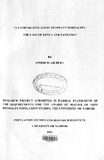| dc.description.abstract | Recent Demographic and Health Surveys have shown reductions in infant mortality rates in Kenya and Tanzania. This study employed survival analysis to demonstrate how various factors are related to infant mortality in the duo and check whether these factors are the same across borders. Cox's Proportional Hazards Model incorporating socioeconomic, geographic, biodemographic and household environmental factors was applied to 2008/09 KDHS and 2010 TDHS data in order to establish the determinants of infant mortality in Kenya and Tanzania.
The results in the proportional hazards models indicated that level of education of the mother, region, birth order/preceding birth interval, source of water and type of toilet facility in a household were significantly associated with post-neonatal mortality in Kenya. The significant determinants of post-neonatal mortality in Tanzania were mother's occupation, region, source of water and type of toilet facility in a household. Unlike in Kenya where households which use well water were 70 percent less likely to report post-neonatal deaths, the study found out that those in Tanzania were 41 percent more likely to report the death of post-neonates.
The study found mother's level of education, mother's occupation, region and birth order/preceding birth interval to be significantly related to the risk of death of an infant in both Kenya and Tanzania. Mothers with no education had 0.47 and 0.55 higher chances of reporting infant deaths when compared to those with some secondary education in Kenya and Tanzania respectively. Mothers who are not engaged in an occupation are assumed to dedicate a lot of their time on child care so as to ensure their safety and increased chances of survival.
The study found out that mothers who were not working were 0.28 (in Kenya) and 0.36 (in Tanzania) times less likely to experience infant deaths than their counterparts in agricultural activities. Infants in the 4+/<24 months birth order/preceding birth interval category were found to be 0.71 and 0.63 times more likely to die than those in the 2-3/2:24 months birth order/preceding birth interval category in Kenya and Tanzania respectively. The findings of this study have a number of implications for policy and research.
There is need strengthen maternal and child health clinics at health facilities and more staff posted so as to reduce the time taken to see a doctor. Further, since majority of births are to rural dwellers, capacity building for community health workers should be strengthened so as to ensure sustainable primary health care programmes.
The finding that type of place of residence was not significantly related to infant mortality in Kenya despite the 2008/09 KDHS finding that infant mortality is high in urban than rural areas is a call for further research on rural-urban differentials in infant mortality in Kenya. For Tanzania, there is need to conduct a study with emphasis on the effect of maternal age on infant survival. | en_US |

